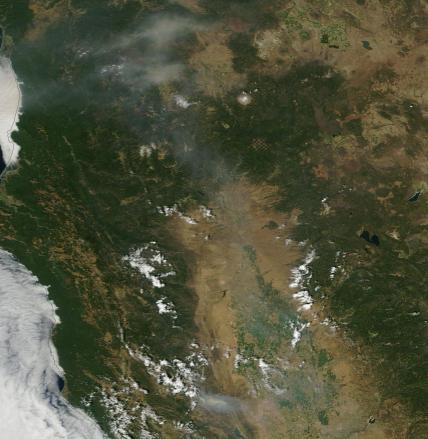An
Army of Firefighters Battles 14 Blazes in Triple Digit Temps Across
California — More than 1,000 People Displaced
31
July, 2015
It’s
becoming all too clear that we’re rolling with some seriously
loaded climate dice.
California,
suffering through its second year of a desiccating 1,000 year
drought, is now facing down a new set of related tragedies. Over the
past few days temperatures rocketed into record triple digit heat.
The Golden State, turning more and more into the withered Brown
State, faced hot Santa Anna winds and a new eruption of dangerous
fires
According
to news reports,
14 major fires are now absorbing the efforts of an army of 7,000
firefighters and California National Guard members. In total, more
than 1,000 people have been displaced by the fires raging throughout
Northern and Central California. Ten structures, including
homes, along with boats and vehicles, have been destroyed even as
more than 300 are now threatened.
Of the most intense and dangerous fires, the largest fire covered 13 square miles in Lake County. That single blaze alone forced 650 residents to evacuate and destroyed two homes. As of late Thursday night, this dangerous fire was only 5 percent contained. Nearby, Brenna Island saw a brush fire tear through a mobile home park destroying six structures along with numerous boats and vehicles. In Nappa Valley, a 12 square mile inferno spread beyond containment lines to threaten 136 structures — forcing another 200 people to evacuate. Over on the shores of Bass Lake a fourth fire nearly doubled in side — surging from 3 square miles to five square miles in just one 24 hour period. As the Bass Lake fire encroached upon the Cascadel Woods community another 400 persons residing in approximately 200 homes were forced to flee. By early this morning, the rapidly expanding fire was only 30 percent contained.
(A
pallor of wildfire smoke lingers over Northern California as blazes
erupt under sweltering heat and gusty winds. At right of frame also
note that the mountain snow pack is basically nonexistent. Image
source: LANCE-MODIS.)
By
yesterday afternoon, smoke from these wildfires was beginning to show
up in the NASA/MODIS satellite shot. A dark pallor and haze that is
all-too-likely to expand over coming days as temperatures in the
middle 90s to lower 100s (Fahrenheit — 35 to 41 Celsius in the
metric conversion) are expected to remain in place through next week.
California
Continues to Suffer Through a Climate-Change Linked Drought
Off-shore,
a massive pool of hot water continues to worsen California’s
misery. The hot pool, also called The Blob, has maintained sea
surface temperatures in the range of 3-5 degrees Celsius above
average for the better part of two years now. These record hot
Northeastern Pacific Sea surface temperatures, in turn, aided in the
development of a persistent high pressure ridge. To the north, a
recession of sea ice in the Arctic Ocean has aided the ridge —
allowing the Jet Stream to surge northward over Alaska, Canada and,
at times, into the High Arctic itself. The result is a kind of
hyper-ridge feature. An obnoxiously long-lasting and vast spike of
hot, dry air driving deep into the polar zone itself (hear
more about the ridge and other climate change related extreme weather
features in a recent radio chat I had with Hal Ginsberg).
For over two years, this ridge has warded off rainfall-granting
storms all while baking California and the U.S. West Coast under
month-after-month of record heat.
(US
Drought Monitor shows exceptional drought maintaining its grip over
nearly half of California. Meanwhile, 97.5 percent of the state
suffers moderate to exceptional drought. To this point, California
has experienced more than 90 percent of its land mass under drought
for nearly two years now. Image source: The
US Drought Monitor.)
The
result is that fully
59 million people across the US West alone
now suffer from drought. But the epicenter of this historic and
unprecedented event is California. There, 97.5 percent of the state
is still sweltering under drought conditions with a huge swath
through the central portion continuing to experience the most extreme
conditions we have a measure for.
Can
a Powerful El Nino Beat Down the Ridiculously Resilient Ridge?
The
California drought is now so intense that the
state has lagged one year behind in rainfall.
In other words, for the drought to end, nearly two feet of rain would
need to fall over every inch of this parched and burning state.
Earlier this month, an anomalous monsoonal pattern dumped an inch of
rain over sections of San Diego. But this odd storm only effected the
extreme south while the rest of California continued to dry out. And
so the epic drought continues with no real hope for relief until
Fall.
Then,
an El Nino, which
is likely to be one of the top 3 strongest ever seen,
may begin to send a series of powerful storms marching toward the US
West Coast. But for that to happen the warm water zone off the
California coast must fade, its associated high pressure systems must
fail, and the Jet Stream which has tended to dive north into the
Arctic, must flatten. That’s what we pin our hopes on now for
California rains — an El Nino strong enough to smash the
Ridiculously Resilient Ridge and to, for a short time, alleviate some
of the more brutal impacts of human forced climate change. A respite
that may not come at all. Or, perhaps just as bad, when it does come
— dump that 2 feet of rain all at once.
Links:





No comments:
Post a Comment
Note: only a member of this blog may post a comment.